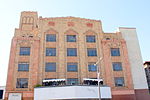Philadelphia Military Academy

Philadelphia Military Academy (PMA) is a military school in North Philadelphia, Pennsylvania. The school opened for the 2004–2005 school year as the Philadelphia Military Academy at Leeds in the Cedarbrook neighborhood of Philadelphia. The school opened with an enrollment of 157 ninth grade cadets. The academy was housed at the Leeds middle school. A second edition of the program was housed at Elverson High School in the 2005–2006 school year. This site is the current location of the school after a merger in the latter years. PMA is also known for earning their HUD aka honor unit with distinction directly from the army in 2022. After completing a service learning project and was rated 98%
Excerpt from the Wikipedia article Philadelphia Military Academy (License: CC BY-SA 3.0, Authors, Images).Philadelphia Military Academy
West Susquehanna Avenue, Philadelphia
Geographical coordinates (GPS) Address Nearby Places Show on map
Geographical coordinates (GPS)
| Latitude | Longitude |
|---|---|
| N 39.9859 ° | E -75.1544 ° |
Address
Philadelphia Military Academy at Elverson
West Susquehanna Avenue
19121 Philadelphia
Pennsylvania, United States
Open on Google Maps





